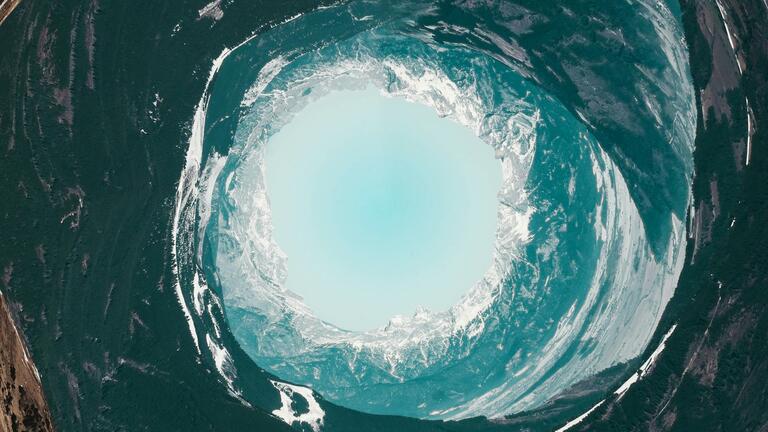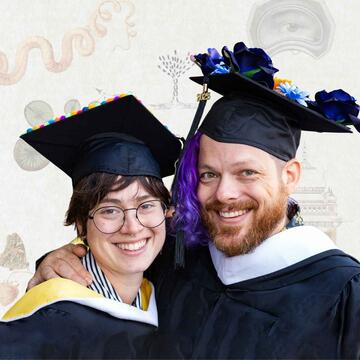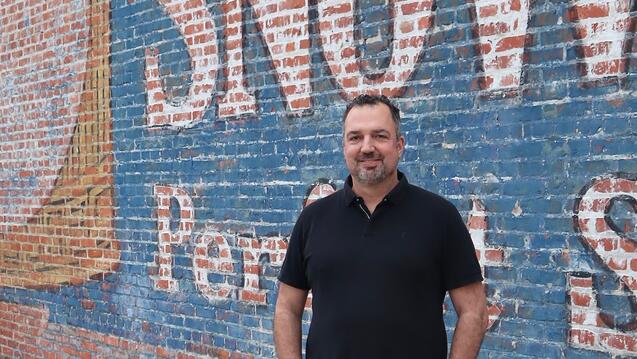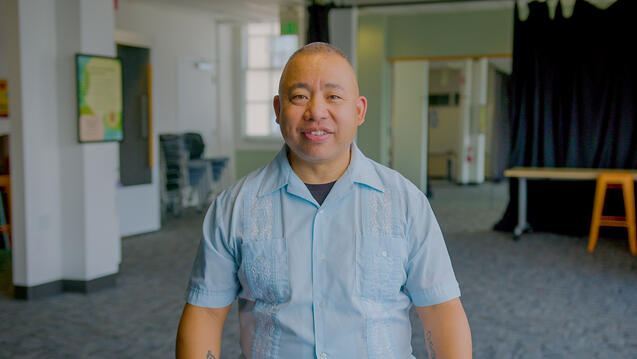Playwright and activist Alex Burger brings his global experience into the CIIS MFA classroom, teaching art as transformation, and crisis as creative fuel.

What to Do with Climate Emotions
Read about CIIS Professor Leslie Davenport's critical work on climate distress and eco-anxiety in the July 10th issue of The New Yorker Magazine
CIIS Editor’s note: The following article appeared in The New Yorker and features Leslie Davenport, MA, MS, LMFT, Associate Professor and Program Lead for the Climate Psychology Certificate program, the first such program of its kind in the United States. Learn more about Professor Davenport and the CIIS Climate Psychology Certificate program.
Tim Wehage grew up in South Florida. At home, the TV was often tuned to Fox News, where he heard a lot of rants about liberal hypocrisy, but he didn’t consider himself political. After high school, he began working for his family’s construction business. He had no intention of going to college until he realized that he didn’t want to spend his adulthood doing manual labor in the tropical heat. In college, as a mechanical-engineering major, he learned about renewable energy and about the science behind global warming. In 2017, a couple years after graduating, he moved across the country, to Seattle, to take a job with a company that improves the energy efficiency of chilled-water facilities—the systems that produce cold air for data centers, hospitals, and universities. He was carless, and walked everywhere. He became a vegan. He loved being immersed in the beauty of the Pacific Northwest.
He hadn’t travelled much as a kid, and he decided to have a peripatetic 2019, under the auspices of a company called Remote Year, which set up monthlong stays for remote workers in twelve different cities. In Kuala Lumpur, the air was opaque. In Hanoi, he developed sinus issues, and thought about how the city’s nearly eight and a half million inhabitants breathed this air every day of their lives. He heard from a local that orangutans were going extinct in Indonesia; he felt dazed by grief. He took a tour of the Sumatran jungle, hoping to see an orangutan while he still could, and then saw miles and miles of palm-oil plantations, where the orangutan’s native habitat had been clear-cut for the consumer crop. The guide asked who in the group was American, and if any of them checked food labels to see if the product contained palm oil. “Well, when you don’t do that, this is what happens,” the guide said.
“For years, you read all the articles,” Wehage told me recently, over the phone. “You look at pictures of the pollution, you think about the greed that fuels it, and you feel upset. But then, when you’re there, you understand that it’s so much worse than anything you could read.” He returned to Seattle overwhelmed. He started checking labels for palm oil, but knew that wasn’t enough. He couldn’t stop thinking about the carbon footprint from all his flights, and how, in some of the cities he visited, the local water was so polluted that the only potable option came in plastic bottles. Then the pandemic set in. Wehage went through a breakup, and began to spend every day alone in his spare, undecorated apartment. (He hadn’t wanted to purchase anything unnecessary that would just end up in a landfill.) He went on long walks, sometimes carrying a trash bag to clean up the streets, but a sense of powerlessness weighed on him: seeing car commercials every two minutes on television, getting on Reddit and reading endlessly about climate doom. He stopped enjoying the things he used to like: playing basketball, going hiking.
Therapy wasn’t really a thing people did where he grew up, Wehage thought. But, after some prodding from friends and family, he decided to seek it out. He came across the Web page of the Climate Psychiatry Alliance, which has a list of more than three hundred climate-aware therapists—practitioners who recognize climate change as a major cause of distress and have developed methods for discussing and treating it. He e-mailed and called a dozen of those listed, but none had any availability. He tried a dozen more therapists in his city before finding someone who could see him. When Wehage told her what was bothering him, she said that she talked about the climate crisis with most of her clients. “After so much isolation, just to think, I’m not alone—it made me get tears in my eyes,” Wehage told me.
The therapist nudged him toward the realization that checking climate-change Reddit for an hour first thing in the morning might not be helpful, and encouraged him to be gentler with himself. Wehage decorated his apartment with finds from local Buy Nothing groups and plants from a nearby nursery. He cut out most social media. He went on a solo overnight backpacking trip, a prospect that had always scared him, and met a group of hikers who invited him to drink tequila on the beach. They talked about climate change, and about everything else.
When I first spoke to Wehage, a year ago, he said that, after these sessions, he felt less overwhelmed and more hopeful. He was hoping to get involved with community groups, and had resolved to “stop thinking that I’m a lone wolf and I have to solve the problem just with whatever I can do.” When he starts spiraling, he told me, “I take a deep breath, and let it out, and think, What can I do, individually? What can we do as a society? What policies are in place, and what’s on the table? What is possible with what’s in front of me today?”
It may be impossible to seriously consider the reality of climate change for longer than ninety seconds without feeling depressed, angry, guilty, grief-stricken, or simply insane. The earth has warmed about 2.3 degrees Fahrenheit since pre-industrial times, and the damage is irreparable. Vast zones of hypoxic water expand in the oceans; wild bees, fireflies, and birds are disappearing; one study suggests that around half of trees currently alive will be dead in forty years. A year ago, the pavement melted in Delhi. The year before that brought end-of-days flooding to China and Western Europe; in western North America, one of the most extreme heat waves ever recorded; and an apocalyptic ice storm in the central United States. Thousands of people died in these disasters. Millions perish from pollution, drought, and other climate-related causes each year. “The earth is really quite sick right now,” Joyeeta Gupta, the co-chair of the Earth Commission, said recently, after the organization published a study arguing that seven of eight environmental thresholds needed to protect life on the planet have already been breached. And this, today, is as good as it will ever get within our lifetimes: every day that we step out into the uncanny weather, we experience a better and more stable climate than any we will ever experience again.
Should we change the subject before we get too despondent? There’s no shortage of other crises competing for our attention, and climate change can make knowledge feel pointless, or worse: in the three decades since the first international agreement to reduce carbon emissions, we have released more carbon into the atmosphere than in the rest of human history combined. The ice sheets keep melting, the permafrost keeps releasing its methane, and the future continues to harden into a psychic zone of suffering and dread. By mid-century, hundreds of millions of people will be displaced because of global warming. In a 2021 survey of Gen Z-ers, fifty-six per cent agreed that “humanity is doomed.” And the worse things get, the less we seem to talk about it: in 2016, almost seventy per cent of one survey’s respondents told researchers that they rarely or never discuss climate change with friends or family, an increase from around sixty per cent in 2008.
A couple of years ago, reading a climate report on my phone in the early hours of the morning, I went into a standard-issue emotional spiral thinking about it all. I woke up my boyfriend, seeking consolation; he took in my frenetic wheel-spinning and went back to sleep. The next morning, he drew up a list of thirty action items for us to consider, ranging from phone banking to ceasing international travel to committing eco-sabotage. There were tasks on the list that we had been doing for years—composting food waste, buying secondhand—but many that we had never considered. We had also recently had a baby, whose carbon footprint likely already exceeded that of entire villages in Burundi. I was playing whack-a-mole with my consumer desires. Every day, I felt like a self-serving piece of shit.
“We have come to believe we are entitled to be spared the hassle of caring at this detailed level,” the English psychoanalyst Sally Weintrobe writes in a recent book, “Psychological Roots of the Climate Crisis.” She argues that many of us struggle with a particular kind of neoliberal outlook; that we have been molded into the type of people needed to prop up the economy of consumption that has despoiled the planet, people who cling to the idea that the world can and should stay the same. Weintrobe is a founding member of the Climate Psychology Alliance, which, like the Climate Psychiatry Alliance—and a handful of other, similar professional associations—is dedicated to the idea that the disciplines of psychology and psychiatry can help us not only to understand the climate crisis but also to do something about it.
I first spoke to Tim Wehage after reading Weintrobe’s book; I also spoke with psychologists, activists, and others about what are sometimes called “climate emotions,” in an effort to consider the principles of climate therapy. I was drawn to the idea that the right kind of therapist could channel such emotions in a way that prompted serious and sustained efforts to combat climate change. I was also wary of the possibility that a therapist would simply dispel those feelings, helping me to feel more calm about a world on fire. If the goal is for the planet to remain habitable into the next century, what is the right degree of panic, and how do you bear it?
Leslie Davenport, a licensed therapist in Washington State, is a pioneer in the climate-therapy field. In the nineteen-eighties, she became anxious about what was happening to the planet, and did things to allay that anxiety: she signed petitions, she searched for environmental organizations that she could support. Then it occurred to her that climate change was caused by human behavior, and human behavior was her field of expertise. “So much of what we’re trained in, in the mental-health field, is to break through denial, to work with grief, to motivate life-style changes, to facilitate contentious conversations,” she said, when we spoke on the phone. “We’re trained to do all these things that are needed to equip people to respond to the climate crisis.” Davenport wrote a book, “Emotional Resiliency in the Era of Climate Change,” aimed at helping clinicians recognize when patients were struggling with the issue. She has since pushed for climate-related training requirements and created programs for therapists similar to the modules that are mandated on such topics as elder abuse and self-harm.
Climate anxiety differs from many forms of anxiety a person might discuss in therapy—anxiety about crowds, or public speaking, or insufficiently washing one’s hands—because the goal is not to resolve the intrusive feeling and put it away. “It’s not a keep-calm-and-carry-on approach,” Davenport told me. When it comes to climate change, the brain’s desire to resolve anxiety and distress often leads either to denial or fatalism: some people convince themselves that climate change is not a big deal, or that someone else will take care of it; others conclude that all is lost and there’s nothing to be done. Davenport pushes her clients to aim for a middle ground of sustainable distress. We must, she says, become more comfortable in uncertainty, and remain present and active in the midst of fear and grief. Her clients usually struggle with this task in one of two ways, she said: they tend to be activists who can’t acknowledge their feelings or people so aware of their feelings that they fail to act.
What would she say, I asked, if I were her client, and had started to feel that no actions would be sufficient? “Every time I touch plastic, I imagine getting to the gates of heaven and being presented with the sum total of nonbiodegradable garbage I generated over my lifetime,” I told her. “Every time I let the faucet run too long while I’m doing the dishes, I picture a toddler holding an empty cup.” I described my sense that, as a Western consumer, bliss requires ignorance, and that we build our good lives on the sufferings of others. Were these healthy thoughts?
Davenport paused, and murmured sympathetically. “O.K.,” she said. “If someone were not as concerned, I would encourage them to keep their eyes more open in an accountable way. For what you’re describing, I might encourage you to back up a bit. As trite as this sounds, I would remember the guide of the Serenity Prayer, and task yourself with doing what you can do and accepting what you can’t do in any particular moment.” She added, “I would advise trying to contain these feelings within one hour every day, where you can feel those worries and evaluate whether you can take action and make plans.”
Thinking about Davenport’s response later, I realized that there were three things she had not done that I had, by that point, come to expect in climate conversations. First, she had not played down individual responsibility: no shoulder-shrugging about how the plane was going to fly whether or not we were on it. She hadn’t given me any credit for trying or caring—no “At least you’re doing cloth diapers. That’s great!” She also hadn’t suggested that any of my visions of garbage mountains and thirsty toddlers were in themselves maladaptive. “She didn’t lie to you, because she wasn’t lying to herself,” a friend said, when I described the exchange.
Still, Davenport’s advice about the Serenity Prayer reminded me of Andreas Malm’s assessment, in his book “How to Blow Up a Pipeline,” that the climate movement thus far has been “gentle and mild in the extreme.” The luxury I had of pondering my emotions at length was evidence of how much closer I was to the problem than to the solution: climate change’s worst effects will always fall on the poor and disenfranchised, both locally and globally, and in this context it was hard to believe that the project of teaching the world’s most fortunate people how to feel was more than another form of self-absorption. I wondered whether I was getting the wrong lessons, however right they seemed.
“In the West, they’re just endlessly processing, going to therapy for their emotions, going to the urban parks that we don’t have and thinking about the earth, and journaling about it,” Isabella Tanjutco told me, over Zoom, a few weeks after I first spoke to Davenport. “Good for you that you can do that, but we can’t.” Isabella is twenty-two and now goes to Parsons School of Design, in New York. She and her sister Natasha, who is twenty-three, grew up in Manila and became climate advocates as teen-agers. By some estimates, the Philippines, an archipelago of more than seven thousand islands, which contributes less than half a per cent of global carbon emissions, is the nation most at risk from climate change: sea levels are rising faster around the country than they are globally, and most of the population lives at low elevation, near the coast. The Tanjutcos grew up in a well-off family, but they grasped, as children, the overwhelming burden that the worsening typhoons placed on the poor. Natasha remembers going out to volunteer with her grandmother after Typhoon Ketsana, in 2009, the eighth Pacific Typhoon of the season, which had caused more than three hundred fatalities. “The sky was clear and sunny, and the storm had been over for days, but the community was still wrecked, and that shocked me,” she said. She was eight at the time.
When the sisters were fifteen and thirteen, respectively, they started an organization called Kids for Kids, enlisting their friends and peers to put on festivals that raised money for typhoon relief in minority and Indigenous communities. They talked about how it wasn’t normal, that it shouldn’t be acceptable, that the typhoons were getting noticeably worse every year. They wanted to keep the tone positive without shying away from systemic issues. They found that their fellow-teenagers responded to forthrightness—they were plenty capable of handling complex and troubling subjects, and they appreciated an emphasis on the local culture, and on turning fear and anxiety into agency and accountability.
I asked Natasha and Isabella how they processed their own climate emotions. They told me that they had never felt more grief and anxiety than they did during the U.N.’s twenty-sixth climate-change conference in Glasgow, known as cop26, in 2021. They participated in their first climate strike there, but found themselves thinking, the whole time, about how nearly impossible it was to take to the streets in the Philippines, where environmental activists are frequently murdered. They felt alienated by the idea that you could demand accountability from your government—and then wait. Like other activists from vulnerable island countries, the Tanjutcos were anticipating the announcement of a “loss and damage” fund of a hundred billion dollars—a mechanism for wealthy nations, which have caused the bulk of climate change, to aid the poorer ones that are bearing its gravest consequences. Instead, cop26 merely announced “further dialogue” on the subject. (At cop27, this past November, the U.S. and other wealthy countries at first advocated not to establish such a fund, but instead “to launch a process to identify appropriate funding solutions with a decision on an outcome at a later stage.” Ultimately, they agreed to establish the fund, and an advisory committee is expected to bring recommendations for the fund’s operations to cop28, next year.)
The Tanjutcos felt that the leaders around them in Glasgow regarded the global South as expendable and accustomed to suffering; the sisters couldn’t believe that everyone was acting as if there was still time. “No one can make a proper decision from an air-conditioned room,” Natasha told me. “People say this new generation has ‘eco-anxiety,’ that they’re worried about the future, and I’m, like, ‘Dude, we’re worried about today.’ ” The sisters recounted scenes from the night Typhoon Ulysses struck, in November, 2020. Tuguegarao, one of the affected cities, had had insufficient warning—during the pandemic, the national government had closed down the largest TV network in the country, a primary source of crisis information. “So everyone was blindly leading each other around in the dark, with no electricity, and the water rising in their houses,” Isabella said. “Trying to get to their roofs, trying to get people out of the water with their cell-phone flashlights.” The Tanjutcos were awoken at 2:00 a.m. by a barrage of messages. They panicked, then started organizing members of Kids for Kids and other organizations to make a spreadsheet with people’s addresses, contact information, and needs. They got on social media, raised money, and, during the next couple of days, funded and sent out ten rescue boats with food, water, medicine, and housing materials. Several local governments ended up using the Kids for Kids spreadsheet to track displaced families.
“When you’re seeing, live, your people drowning—that’s not climate anxiety,” Isabella said. “We were watching people screaming in the rising water, looking for their kids. We were crying. You do have to process those emotions, but, in the moment, you don’t have time. You’re in survival mode. So we were also texting people to mobilize them.” Natasha added that Westerners always seemed to be looking for a linear course of action, “to figure out how to feel, then figure out how to act, then act. But here, we just act, and we feel things during, we feel things after, and then we act again.”
Dune Lankard was thirty when, in March, 1989, the Exxon Valdez spilled eleven million barrels of oil into the waters of Prince William Sound, where his family had fished for generations. “It was like climate change happened overnight,” he told me. “The prices of our boats and permits collapsed. There were divorces and suicides and fishing-coöperative breakups. Friends and family were fighting. Alcoholism, drugs—everything was rampant.” The herring came through the sound, surfacing and gulping only oil. Lankard, a member of the Eyak people, remembers going out every day into the water to try and clean the kelp and seaweed, feeling like he was fighting in a war that had already been lost. Watching what was happening to his community—“the disarray, the dysfunction, the loss of hope”—he was overpowered by anger and sadness.
Lankard had started going out on the water in Prince William Sound when he was five years old. Nature was plentiful and magnificent: during the annual herring run, the fish would surface in the moonlight to gulp the air, and the water turned into glimmering silver dollars. He learned a lifestyle of subsistence; he also learned a history of land loss and exploitation of natural resources, how “every group of people that’s come here” after his people “has tried to take everything that wasn’t nailed down.” As a kid, he saw modern fishing vessels come onto the waters and felt a wave of dread. “You could see that the people on those boats lived different lifestyles than our Native community did,” he said.
One rainy day, after the Exxon Valdez disaster, Lankard went down to Eyak Lake and, “ranting and raving,” asked his ancestors for guidance—for a green arrow toward becoming an activist. After an hour, the drizzle stopped and the northern lights emerged, chartreuse. Lankard went on to found multiple nonprofits, including the Native Conservancy, the first Indigenous-led land trust in the States. He still serves as its executive director. Since its founding, he has led efforts that have protected more than a million acres of Alaskan land. He also helps Indigenous fishermen start kelp farms, which combine the promise of good jobs, food sovereignty, and carbon sequestration. “This is just one of the thousand things that need to be funded, that need to happen, if we really care,” he said.
As we spoke, Lankard was free with his grief, and with his sense that humans were reaching a point of self-extinction. “We need our emotions,” he told me. “We just need to be proactive with them, rather than reactive. I’m a river rafter, and you learn that you have to face the danger, whether it’s a whirlpool or rapids or a bear. You have to face your danger to know what it is, and to pull away.”
Lankard, who is now in his sixties, has a thirteen-year-old daughter, and I asked him how having a child had affected the way he thought about climate change. Lankard told me that, when he held his daughter for the first time, he realized that the decades of activism behind him had been driven by anger and frustration, by a sense of having been injured. He grasped then that his emotional motivation would be different. He would do the work in front of him because of the love he has for his daughter, who reminds him, simply by being here, that there is no way around the future.
A year after I first spoke with Davenport, I got in touch with her again. In recent months, activists with the group Just Stop Oil had staged stunts that ranged from the silly (throwing soup at van Gogh’s “Sunflowers”) to the focused (smashing gas-station pumps). A group called the Tyre Extinguishers had deflated ten thousand S.U.V. tires in New York, London, and other cities. Pipelines, both fictional and real, were being sabotaged. In her book, Davenport characterizes eco-terrorism as an example of an unhealthy drive toward extreme, obsessive action. “We have to find a way to be with the imperfection of the process,” she told me, during our first conversation. “We have to keep our antennae up, so we can see openings to add our voices, to be there at the pivotal place where there might be a collective shift.” But, I asked her, what if these tactics represented the collective shift we were supposed to be looking for? Does eco-sabotage match the extremity of the problem?
“Yes, 100%!” Davenport replied. But, she added, “is it effective in moving toward the needed transformation?” Behavioral-science research, she said, suggested that strategies that aroused regret, guilt, or fear were the least likely to inspire change. Strategies that inspired hope and action—like passing a clear-air initiative in your community—were the most effective. She pointed to studies showing that only about a quarter of people in a social group needed to make a shift before significant social change followed.
A few days after I got Davenport’s e-mail, smoke from Canadian wildfires drifted southward, and the sky above New York City turned into an orange haze. I thought of a passage in the book “Learning to Die in the Anthropocene,” by Roy Scranton: “We can continue acting as if tomorrow will be just like yesterday, growing less and less prepared for each new disaster as it comes, and more and more desperately invested in a life we can’t sustain. Or we can learn to see each day as the death of what came before, freeing ourselves to deal with whatever problems the present offers without attachment or fear.”
Climate therapy, I had come to think, could help people find this place of acceptance, shifting them into engagement or allowing them to remain there without losing their marbles. But the practice seems rooted in a faith that the world and the future will be best served by us maintaining our sanity—a sensible enough creed, though I don’t always share it. Later, I checked in with Tim Wehage, who told me that he had gone back to therapy, and that further sessions had led him to an additional breakthrough: he had been miserable in part, he said, because he’d been struggling with undiagnosed A.D.H.D. He’d gone on medication, and in the new quiet of his mind he’d come to suspect that he’d sometimes used climate anxiety as a container for his own, more intimate problems. “Don’t get me wrong, the general state of our very existence being threatened by a warming planet is still frequently on my mind,” he told me, “but it hasn’t haunted me like it was doing before.” He added, “There are people in society who are built to take on improving towns, cities, countries. I am not one of those people, and that is O.K.”
Related News
Fernando Ona, Chair of Transformative Inquiry at CIIS, carried questions from Iraq to the classroom—and found space to explore them.
Discover the latest works from CIIS faculty—spanning psychology, spirituality, ecology and the arts. These recent publications show how our community is advancing scholarship and creativity in service of personal and collective transformation.





